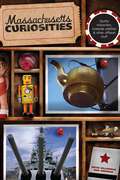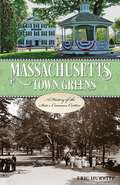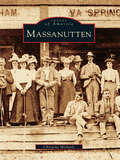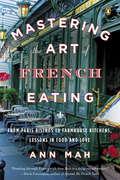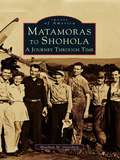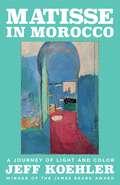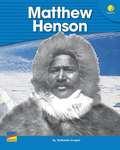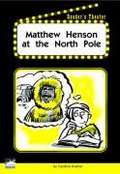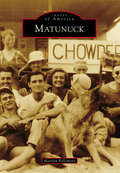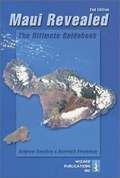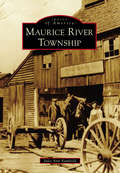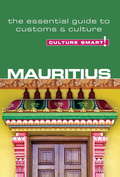- Table View
- List View
Massachusetts Breweries (Breweries Series)
by John Holl April DarcyThe definitive guide to Massachusetts's 46 breweries and brewpubs.
Massachusetts Curiosities: Quirky Characters, Roadside Oddities & Other Offbeat Stuff (Curiosities Series)
by Erik Sherman Bruce GellermanDiscover more than 200 of the wildest, wackiest, most outrageous people, places, and things the Bay State has to offer in this completely revised and updated edition.
Massachusetts Off the Beaten Path®: Discover Your Fun (Off the Beaten Path Series)
by Maria OliaDiscover some of Massachusetts's unique offerings with this guide: Visit a wooden boat shop that has been in business since 1793; admire the pressed glass galleries at the Sandwich Glass Museum, or travel back in time at the nineteenth-century Old Sturbridge Village.
Massachusetts Town Greens: A History of the State's Common Centers
by Eric HurwitzThe state of Massachusetts still has and continues to celebrate its town or village greens. These greens date back to Colonial times where they served as the physical and spiritual centers for these early towns. Today many town greens continue to be the center of town events, fairs, and other gatherings. Massachusetts Town Greens explores the history of these remarkable greens and provide a guide to current events.
Massanutten
by Christine MichaelsMassanutten, a 50-mile-long mountain range, ends in a striking peak in the Shenandoah Valley of western Virginia, splitting the Blue Ridge Mountains fromthe Alleghenies and the North and South Forks of theShenandoah River. Once an area where Native Americansdwelled and perhaps cultivated the land, Massanutten boasted healing springs that blossomed to become a four-season resort. Private homes intermingle with a conference center, timeshares, and condominiums in an area of preserved woodland heritage. This volume chronicles the history and development of this part of the mountain range, from its use as a Civil War lookout point to a modern-day ski resort complete with golfing and a water park. Included are glimpses of sports, business, and political notables like Lance Armstrong, Del Webb, and Bob Mathias, who have made their marks here--either as guests or in the development of the resort itself.
Master Pongo: A Gorilla Conquers Europe (Animalibus)
by Mustafa HaikalIn the summer of 1876, Berlin anxiously awaited the arrival of what was billed as “the most gigantic ape known to zoology.” Described by European explorers only a few decades earlier, gorillas had rarely been seen outside of Africa, and emerging theories of evolution only increased the public’s desire to see this “monster with human features.” However, when he arrived, the so-called monster turned out to be a juvenile male less than thirty-two inches tall. Known as M’Pungu (Master Pongo), or simply Pongo, the gorilla was put on display in the Unter den Linden Aquarium in the center of Berlin. Expecting the horrid creature described by the news outlets of the time, the crowds who flocked to see Pongo were at first surprised and then charmed by the little ape. He quickly became one of the largest attractions in the city, and his handlers exploited him for financial gain and allowed doctors and scientists to study him closely. Throughout his time in Europe, Pongo was treated like a person in many respects. He drank beer, ate meat, slept at the home of the head of the aquarium, and “visited” London and Hamburg. But this new lifestyle and foreign environment weren’t healthy for the little gorilla. Pongo fell ill frequently and died of “consumption” in November 1877, less than a year and a half after being brought to Europe.An irresistible read, illustrated with contemporaneous drawings, this critical retelling of the expedition that brought Pongo to Berlin and of his short life in Europe sheds important light on human-animal interactions and science at a time in Western society when the theory of evolution was first gaining ground.
Master Pongo: A Gorilla Conquers Europe (Animalibus: Of Animals and Cultures #17)
by Mustafa HaikalIn the summer of 1876, Berlin anxiously awaited the arrival of what was billed as "the most gigantic ape known to zoology." Described by European explorers only a few decades earlier, gorillas had rarely been seen outside of Africa, and emerging theories of evolution only increased the public’s desire to see this "monster with human features." However, when he arrived, the so-called monster turned out to be a juvenile male less than thirty-two inches tall. Known as M’Pungu (Master Pongo), or simply Pongo, the gorilla was put on display in the Unter den Linden Aquarium in the center of Berlin. Expecting the horrid creature described by the news outlets of the time, the crowds who flocked to see Pongo were at first surprised and then charmed by the little ape. He quickly became one of the largest attractions in the city, and his handlers exploited him for financial gain and allowed doctors and scientists to study him closely. Throughout his time in Europe, Pongo was treated like a person in many respects. He drank beer, ate meat, slept at the home of the head of the aquarium, and "visited" London and Hamburg. But this new lifestyle and foreign environment weren’t healthy for the little gorilla. Pongo fell ill frequently and died of "consumption" in November 1877, less than a year and a half after being brought to Europe.An irresistible read, illustrated with contemporaneous drawings, this critical retelling of the expedition that brought Pongo to Berlin and of his short life in Europe sheds important light on human-animal interactions and science at a time in Western society when the theory of evolution was first gaining ground.
Mastering the Art of French Eating: From Paris Bistros to Farmhouse Kitchens, Lessons in Food and Love
by Ann MahThe memoir of a young diplomat's wife who must reinvent her dream of living in Paris--one dish at a time When journalist Ann Mah's diplomat husband is given a three-year assignment in Paris, Ann is overjoyed. A lifelong foodie and Francophile, she immediately begins plotting gastronomic adventures a deux. Then her husband is called away to Iraq on a year-long post--alone. Suddenly, Ann's vision of a romantic sojourn in the City of Light is turned upside down. So, not unlike another diplomatic wife, Julia Child, Ann must find a life for herself in a new city. Journeying through Paris and the surrounding regions of France, Ann combats her loneliness by seeking out the perfect pain au chocolat and learning the way the andouillette sausage is really made. She explores the history and taste of everything from boeuf Bourguignon to soupe au pistou to the crispiest of buckwheat crepes. And somewhere between Paris and the south of France, she uncovers a few of life's truths. Like Sarah Turnbull's "Almost French" and Julie Powell's "New York Times" bestseller "Julie and Julia," " Mastering the Art of French Eating" is interwoven with the lively characters Ann meets and the traditional recipes she samples. Both funny and intelligent, this is a story about love--of food, family, and France.
Mastering the Travel Intermediaries: Origins and Future of Global Distribution Systems, Travel Management Companies, and Online Travel Agencies (Management for Professionals)
by Ben VinodThis book chronicles the role of travel intermediaries: global distribution systems (GDS), travel management companies (TMC), and online travel agencies (OTA) in the distribution of travel products. The book covers the historical development of these intermediaries and explores their current state and future prospects. Almost six decades after the introduction of computerized reservations systems and four decades after the introduction of Global Distribution Systems that allowed travel agents to make automated airline bookings, the distribution of air products is amid a major transition. A fundamental change is pricing power, which shifts from the GDSs to the airlines for the indirect channel. These changes are driven by advancements in technology, market economics, and airline cost controls, leading to the emergence of new revenue models that will permanently alter the landscape of air distribution. As a result, travel intermediaries are experiencing the effects of these turbulenttimes and must adopt innovative approaches and initiatives to adapt and transform their business models rather than maintaining the status quo. In addition to the ongoing transformation, over the next decade, the advancements in emerging technologies like blockchain and decentralized digital identity will further revolutionize the distribution landscape across all sectors of the travel industry.
Matagorda County
by Matagorda County Museum AssociationMatagorda County is centered in the Texas Coastal Bend at the crossroads of the Colorado River and the Gulf of Mexico. The name Matagorda, Spanish for "thick brush," was derived from the canebrakes that formerly lined the extensive shoreline. This vast coastal prairie is rich in history and tradition, with its roots dating back to 1685 when the explorer LaSalle sailed into Matagorda Bay. Later Stephen F. Austin used the seaports of Matagorda and Brazoria to build his new colony. The Gulf of Mexico, the rivers, the rich agricultural soil, the natural habitat full of wild game and birds, and the determined spirit of the people make the cities of Bay City, Palacios, Blessing, Sargent, and Matagorda an exquisite mix of history and tradition.
Matamoras to Shohola: A Journey Through Time
by Matthew M. OsterbergMatamoras to Shohola: A Journey Through Time tells the story of the Matamoras, Mill Rift, Westfall, Milford, Shohola, and Dingman Township people from 1860 to 1960. This exquisite collection of images features all aspects of life in theses areas, from the tourism industry to transportation to notable figures in history. Author and local historian Matthew M. Osterberg combines an impressive and unprecedented collection of photographs with a thoroughly researched text in this timeless tribute to the people and places of these Pennsylvania towns. Still a popular weekend and summer retreat for residents of New York and Philadelphia, Matamoras has attracted many tourists over the years. Included in this remarkable collection are images of the hotels and boarding houses of yesteryear. View the Hotel Fauchere, built in 1852 by Louis Fauchere, a chef at Delmonico's in New York and where Lobster Newburg was created. Also included are images of actress Lilliam Gish and philosopher Charles Peirce, the founder of Pragmatism. Discover the tranquility of tree-lined streets and splendid homes, and the farms that have since vanished in an age of shopping centers. Depicted in the collection is the crucial role that water continues to play inn both the commerce and recreation of these communities. Remy Loreaux, proprietor of the Silver Spring House Brewery, produced the first American bottled beer in Dingman Township.
Mathematical and Computational Intelligence to Socio-scientific Analytics and Applications (Lecture Notes in Networks and Systems #518)
by Pankaj Srivastava Georgia Irina Oros M. Lellis Thivagar Chai Ching TanThis book presents a collection of selected papers presented at the 22nd FAI International Conference on Mathematical, Computational Intelligence and Engineering Approaches to Healthcare, Business and Tourism Analytics (FAI-ICMCIE 2020), held at American College, Madurai, India, from 20–22 December 2020. This book discusses advanced mathematical concepts and computational intelligence approaches for: medical diagnostic approach in cardiac diseases, nano topology in medical diseases, stability of indicators in assessing business development, AI-guided paradigmatic competence in science and spirituality integration, neural network-TOPSIS analytics in hotel service quality, itinerary planning destination ranking tourism analytics, molecular modeling and docking simulation for unraveling medicinal properties, value-oriented approach on commercial banks security, Brownian motion in shares of the bank, internet of things linking to social media and e-commerce, and more, which are discussed by using fuzzy analytics, nano-topology, statistical, TOPSIS and neural network tools.
Mathew Brady: Photographer of Our Nation
by Stuart A MurrayIn a spellbinding account of her two-year teaching stint and travels in China, Woronov provides, through numerous anecdotes, insight into the everyday life of the modern Chinese people. 20 photos.
Matisse and the Bathwater
by Celia WakefieldIn this collection of personal essays, the author ranges across a long and adventurous life. In the opening essay, "Cream Toast in the Dining Room," she recounts a train trip from Connecticut to Maine in 1916, when she was six years old. Later pieces describe travels in Bolivia, Belize, and Morocco, and being shipwrecked on a remote Pacific island. In the final essay she shares her memories of the Japanese attack on Pearl Harbor in 1941.
Matisse in Morocco: A Journey of Light and Color
by Jeff KoehlerThe remarkable and little-known story of the two groundbreaking winters that Henri Matisse spent painting in Morocco, a fertile period that transformed his art and marked his work until the very end.In winter of 1912, Henri Matisse—forty-two, nearing mid-career, and yet to find lasting critical acceptance, public admiration, or financial security since exploding to the forefront of the avant-garde in 1905 with his iconoclastic Fauve paintings—was struggling. Once the vanguard leader, the Parisian avant-garde now considered him passé. His important early collectors, including Gertrude and Leo Stein, had stopped buying his work and were fully championing Picasso, and he had exhibited little in the last few years. In the face of Cubism that was now dominating the art scene, Matisse needed to get away from Paris in order to advance his distinctive artistic vision. Almost on a whim, he went to Tangier. Matisse had already been profoundly inspired by Islamic art, and was primed for his arrival in the Moroccan city where such art was integrated into everyday life. Despite the challenges of rain, insomnia, depression, and finding models, the sojourn was such a success he returned the following winter, which would lead to even greater artistic triumph. Matisse in Morocco tells the story of the artist's groundbreaking time in Tangier and how it altered Matisse&’s development as a painter and indelibly marked his work for the next four decades. Through Koehler's research and travel, we experience Matisse's time in Tangier, the paintings and their subjects, his relationships with his wife Amélie and his two important collectiors, and then come to understand the impact Morocco—its light, colors, culture, and artistic traditions—had on his art. From Landscape Viewed From a Window, to Zorah on the Terrace, from Kasbah Gate to the dream-like tableau Moroccan Café, these works from Morocco are now recognized as some of the most significant and dazzling of Matisse&’s illustrious career.
Matteson (Images of America)
by Paul W. JaenickeThe village of Matteson was founded in 1855 and named after the 10th governor of Illinois, Joel Matteson. German immigrants were the area's first settlers, seeking agriculture and business opportunities. The Illinois Central and Michigan Central Railroads provided the stimulus for the growth of one of the first communities to the south of Chicago. The area became popular in the 1890s, when Chicago residents rode special trains to visit the amusement park run by Moses and Freeman Elliott. By the mid-20th century, the town had established itself as a growing bedroom community due to the electrification of the Illinois Central suburban service in 1926 and an increase in residential housing designed for American GIs returning home after World War II. Transportation has always played a key role in the development of the village, which sits at the crossroads of America's first land grant railroad, the Illinois Central, and the country's first transcontinental road, the Lincoln Highway. Since the 1970s, Matteson has grown intoa vibrant retail and commercial area for Chicago's south suburbs.
Matthew Henson
by Maryann N. WeidtMathew Henson survived poverty and racism as an African American, and he survived the dangers and challenges of the Arctic one of the first people to reach the North Pole. This book tells the story of a man who risked his life to achieve his dreams.
Matthew Henson (Biographies)
by A.M. ReynoldsHow much do you know about Matthew Henson? Find out the facts you need to know about this explorer of the Arctic. You'll learn about the early life, challenges, and major accomplishments of this important American.
Matthew Henson at the North Pole
by Candice Kramer Pam Hirschfeld Karen LeonPerform this script about Robert Peary's discovery of the North Pole and how his assistant, Matthew Henson, played a major role in the expedition.
Matunuck
by Marilyn BellemoreThe village of Matunuck lies on the south coast of Rhode Island in the town of South Kingstown. It was first inhabited by Native Americans, followed by the early Pettaquamscutt settlers, but it was not until after the end of the Civil War that it became a destination for leisure and fun. This took the form of tent colonies on the beach and local farmers that rented out rooms and cottages to summer guests. Today, surfing, fishing, and sunbathing are popular activities at the beloved beaches, yet there is more that draws the thousands of tourists who visit each year. Theatre By The Sea has hosted world-renowned actors like Marlon Brando and Mae West, and beachfront establishments have long attracted a variety of musical acts. The village is also home to a national wildlife refuge, Trustom Pond, that is a safe haven to an array of species and is still preserved today.
Maui Revealed: The Ultimate Guidebook (2nd edition)
by Harriett Friedman Andrew Doughty"A complete traveler's reference to the Hawaiian island of Maui with full color illustrations, maps, directions, and candid advice by authors who reside in Hawaii." Other books about Hawaii are available from Bookshare.
Maui: A Day-by-Day Plan for Your Dream Vacation
by Andrea Lown Rose Gully Geoff MoysaA day-by-day plan for an unforgettable, stress-free vacation in Maui. Rose + Gully has done all the research to create the ultimate holiday with just the right amount of rest and relaxation combined with off the beaten path adventure. This tested, 9-day itinerary takes you through the island's best beaches, snorkeling spots, hidden waterfalls, shopping and more. What's in the guide?The Itinerary:* 9 full-day itineraries with daily activities and meals to help you make the most out of your trip* Local tips and recommendations to get you off the beaten path* West Maui's most spectacular beaches and secluded snorkeling spots, exhaustively tested by Rose + Gully's dedicated team* Detailed day trips for the Road to Hana drive, Haleakala Crater and Upcountry* Additional restaurants, activities and options to customize the itinerary to your unique tastes and budget Accommodations, Car Rentals & Other Logistics:* Recommended accommodations close to the action ranging from posh resorts to cool vacation rentals* Options and advice for Maui car rentals* Handy collection of booking tips, tricks and links plus exclusive Maui deals* Simple, delicious recipes and grocery list using fresh local ingredients for condo rentals with kitchens* Packing checklist designed specifically for Maui weather and activities* Stress-free route to take care of all holiday logistics such as groceries, snorkeling gear, car rentals and more
Maurice River Township (Images of America)
by Julie Ann RumboldThe Maurice River Township area was first settled by the Lenni-Lenape along the Maurice River prior to the arrival of European explorers in the 1600s. The Maurice River became important for many industries, including oystering, commercial fishing, and crabbing. Dorchester and Leesburg, especially the Delaware Bay Shipbuilding Company, were well known for shipbuilding, and the area was very active during World War II. The township has been long recognized for agriculture due to its wonderful sandy ground. The soil has played an important role in the glass industry since the late 1800s, with the silica/sand utilized in a thriving glass-manufacturing business, initially in Port Elizabeth. The railroads were first built to ship oysters to large cities in the late 1800s to mid-1900s but were also employed to transport sand for the glass business and wood for the lumber industry. Many of the enterprises from earlier days have vanished in time, and along with them, some villages have entirely disappeared.
Mauritius - Culture Smart!
by Tim ClearyMauritius is a conundrum. A small, exotic, multiethnic island nation in the Indian Ocean, to some it is a multicultural "rainbow," a haven of peace, love, and understanding. Others see it as ethnically divided, cultivating only "sugarcane and prejudice." Opinions differ as to whether it is a Creole island, a Hindu-dominated Little India, or a neo-colonial outpost of the French-speaking world. Optimists see it as the biggest social and economic miracle of the post-colonial world, whereas pessimists believe it to be a social accident waiting to happen. For many visitors Mauritius appears to be a carefree tropical paradise, but its complexity will baffle any foreigner who dares to leave the comfort of the luxury beach resort. Daily life is far from idyllic for the majority of the population struggling to reconcile traditional culture and old ethno-religious antagonisms with the demands of the modern world. Mauritius is a very new nation, formed over the past three centuries. Although the South and East Asian influence is very strong, its most defining characteristic is its very multiculturalism. Its traditions reflect the diversity of the people, and Mauritian language, food and religion form an intoxicating medley. Other customs have been created locally and are shared by all, such as the lively and popular musical tradition of sega. Modernization and global economics mean many younger Mauritians now share a common culture and outlook on life, where the sense of being Mauritian outweighs ancestral ties and divisive communalism. Culture Smart! Mauritius will help you make sense of the modern and the traditional, of shared and ancestral culture, and enable you to navigate your way through the contradictions at the heart of modern Mauritius. Show the expected courtesy and respect and you will meet many extraordinary, warm-hearted, patient, and friendly people who are keen to welcome outsiders from any part of the world.

